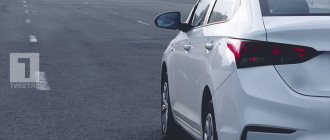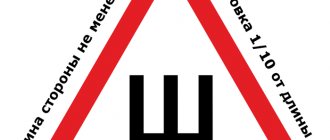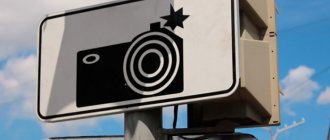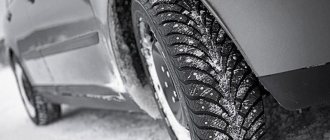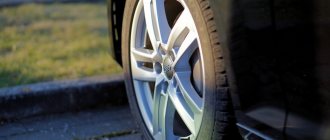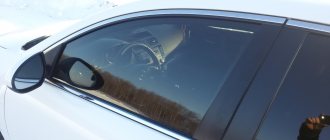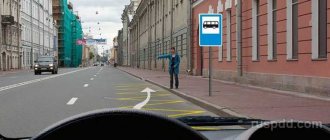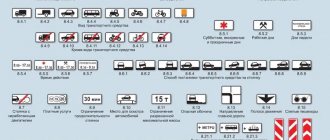According to the amendments to the “Road Rules”, effective from 04/04/17, in Russia it is mandatory to use the “Spikes” sign on cars with installed studded winter tires.
However, not all car owners know about this and the vast majority drive without this sign, which is fraught with certain troubles for them with traffic police inspectors.
From this article you will learn:
- What determines the mandatory installation
- What is it for?
- Penalty for the sign "Spikes"
- Where to put the “Spikes” sign on a car
- What should the “Spikes” sign be like according to GOST
- Absence of the “Spikes” sign in an accident
What determines the mandatory installation
The mandatory installation of the “Spikes” sign on a car is determined by clause 7.15 of the “amendments to the traffic rules” dated April 4, 2021, which lists the list of malfunctions for which the operation of the car is prohibited. The following is written verbatim in paragraph 7.15:
There are no identification marks that must be installed in accordance with paragraph 8 of the Basic Provisions for the admission of vehicles to operation.
At the same time, in paragraph 8 of the Basic Provisions for the admission of vehicles to operation, the following is written verbatim:
The following identification marks must be installed on vehicles: - “Spikes” - in the form of an equilateral triangle of white color with the apex up with a red border, in which the letter “Ш” is inscribed in black.
That is, driving without a “Spikes” sign on a car with installed studded winter tires is considered illegal from 2021. By the way, now everyone can easily identify a car by license plate using the current database.
Why put up a sign?
The “Ш” sign must be stuck on the car, since a car shod with studded tires can provoke a traffic accident. This is due to the fact that the spikes shorten the braking distance of the car, and the sticker is precisely intended to emphasize and warn other drivers. Drivers following behind a vehicle on studded tires may simply not be able to navigate the traffic situation and have time to brake. The sticker should be clearly visible from 20 meters to other car drivers on the road. In addition, quite often there are cases where spikes fly out and damage the car body. This often happens during icy conditions, when the number of wheel revolutions increases sharply due to slipping. The sticker is applied as a warning signal to nearby drivers.
By watching the video you will learn more:
Another factor for placing a sticker on the car window is passing a technical inspection. A car with studded tires and without an identification sticker will simply not be able to pass inspection in the winter season. During the summer months this should not be a problem as spikes are not usually used at this time of year.
What is it for?
It must be said that the need to install a sign is determined not only by legislation, but also by common sense.
Today, the choice of winter tires is huge; non-studded tires (Velcro) are chosen by an increasing number of car owners. However, even in big cities there are many situations where studded winter tires have a shorter braking distance than Velcro tires.
A clearly visible "Spike" sign can actually warn the driver behind you that the stopping distance may be much shorter than he expects. That is, the presence of a sign is, in fact, an additional factor that reduces accidents on the roads. There is no need to neglect them.
What does the spike sign inform road users about?
At first glance, this question may seem somewhat strange. However, it is important to remember that it not only simply informs other drivers that you have studded tires, but also warns them that the presence of studs on the wheels significantly reduces the braking distance of the car in front in slippery conditions. This means that the driver behind you must keep a greater distance to avoid crashing into your car when braking sharply.
Related links: What is a general power of attorney?
That's not all. Studded tires can be of very different quality, and therefore the studs may fly out from under the wheels of the car in front. Motorists following behind must be warned - if they do not want to get a hard object in the windshield, then they should stay away from the car with the spike sign.
Penalty for the sign "Spikes"
Since the absence of the “Spikes” sign is now considered a malfunction, according to Part 1 of Article 12.5 of the Administrative Code, traffic police inspectors have the right to impose a fine of 500 rubles on the car owner.
Literally, part 1 of Article 12.5 reads like this:
Driving a vehicle when there is a malfunction...
...incurs a warning or the imposition of an administrative fine in the amount of five hundred rubles.
That is, if the car owner is very lucky and the traffic police inspector is in a good mood, then he can count on a warning. But with a high probability we can say that there will be a fine.
Statement of the amount of the fine
If there is no corresponding sign on a car with studded tires, then traffic inspectors have every right to stop you on the road and issue a fine.
According to the law of the Russian Federation, the absence of a sign is an administrative offense and entails a fine of 500 rubles.
A fine may be issued if:
- There is no sign on the car with spikes.
- The appearance or size of the sign does not meet the standards.
- Incorrect placement of the sign (it is not visible to drivers from behind).
Drivers of cars with such tires would be much better off installing a sign in the form of the letter “W”. This will help you save money, time, successfully pass a technical inspection and avoid encountering traffic police officers once again.
Where to put the “Spikes” sign on a car
Many car owners also often have a question: where to put the “Spikes” sign? It can be difficult to independently determine the place where it should be installed (there are many options - on the door or trunk lid, on the bumper, on the rear lid of the body, on the awning, some even glue it to a trunk attached to the roof rack).
It should be noted here that except for paragraph 8 of the “Basic provisions for the approval of vehicles for operation,” the location of the sign on the car is not specified by any other documents, including the “Road Rules.”
The following is written verbatim in paragraph 8 of the “Basic Provisions”:
...the sign must be installed at the rear of motor vehicles.
That is, the sign simply must be visible and clearly readable for those road users driving behind your car.
As for the sign sticker itself, you need to remember the following:
- Since the sign should be placed only for the winter (it is not needed in the summer), you need to keep in mind that the sign pasted in the fall will have to be removed in the spring. But this may not be so simple and can even lead to damage to the paint or the glass itself on the car if the wrong place is chosen.
- There are two types of signs - with glue on the front side of the sign and with glue on the back side of the sign. Accordingly, those signs that have glue on the front side are glued from the inside of the car, those on the back side are glued to the outside of the car.
- Signs are produced by many manufacturers; for many of them, the adhesive base can grip too tightly, which will create a lot of difficulties when peeling off the sign in the spring. On the inside of the car glass, its heating filaments can be damaged, and on the outside, even the paint on the car body can be damaged.
- To prevent this from happening, it is best to choose places where you know you won’t be able to damage the car. For example, car glass is perfect for any glue, since scraping off sign and glue residues from it will be much easier than from any other surface. However, if the sticker is supposed to be applied from the inside, it is necessary that there are no heating filaments on the glass.
- When sticking a sign on the car window, do not forget about visibility. The sign must be pasted in such a way that it does not block the view to the rear. The most optimal places for placement will be the upper corners of the rear window of the car. The top left corner works best because it interferes least with your view. The upper right corner can also be used if there are already some stickers in the upper left.
- Also, do not forget that many cars have tinted rear windows, so the sign pasted on the inside will be difficult to read. For tinted cars, an exterior sticker is more suitable. Also, a sign glued to the outside is convenient because you can ask to peel it off at any car wash in the spring.
- There are also a lot of options for “Spikes” signs for internal installation “on suction cups” and other “Velcro”. Here it must be said that the installation of such signs must be checked from time to time, since all these “Velcro” and “suction cups” tend to come off over time.
Where to glue according to the rules?
The “Spikes” sign is attached to the rear of the car - this wording is used in traffic regulations.
You can stick it on the bumper, door and even on the trunk lid if it gets in the way on the glass and blocks your view.
But usually the sticker is placed in the upper right corner of the glass, since it is very easy to miss in other places. The sign can be placed on the outside or inside of the glass, but only if the glass is not tinted.
There are options attached to suction cups; they are considered the most reliable and practical.
It is best if the triangle has one suction cup in each corner, this will hold it tighter.
You can also use a sticker, but in this case, after peeling off, an unsightly mark may remain on the glass. Moreover, the sign on the suction cups can be used for many seasons in a row, and the sticker is designed for only one use.
What should the “Spikes” sign be like according to GOST
It should be noted that in addition to the presence of the sign on the car, it is also necessary that it comply with GOST.
According to GOST, the “Spikes” sign must be an equilateral triangle of white color with a side measuring at least 20 cm, with a black letter “Ш” inscribed in it and a red border along the edges of at least 2 cm (10%) thick.
There are many different signs sold in stores and not all of them comply with GOST; when purchasing, it is better to check the length of the sides of the triangle with a ruler or tape measure.
You can also print the sign yourself; to do this, just download the picture from our website:
Rules for sticking a sign
The law clearly states where to place the “Spikes” sign according to the current rules. According to the law, it is correct to stick the sign on the rear window of the car. If there is tinting, the sign must be glued to the outside of the glass.
The main condition must be good visibility of the sign; it must be visible to other road users from a 20-meter distance. Most often, the sticker is placed at the bottom and in the middle of the glass, but depending on the make of the car, the location of the sign can be adjusted.
Important! Attach the badge in such a way that the driver can clearly see everything and does not interfere with normal driving.
Find out more in the video:
What if I have Velcro and in the warm season?
If you do not use studded tires, then the presence of this identification mark on your car is not necessary. As for the seasonal factor, the only rule you need to remember is that the corresponding sign on the car must appear simultaneously with the installation of studded wheels on it.
Related links: Guarantees for residents of Khrushchevka, which will be included in the 2021 renovation program. New in the legislation of the city of Moscow on the demolition of five-story buildings
It is worth remembering that the use of summer tires in the Russian Federation is prohibited by law in the winter season, as is driving on studded tires in the summer. The rest of the year is left to the discretion of the drivers themselves, who must be guided by local weather conditions. In addition, regional officials, taking into account the climatic conditions of the area, can, by their local laws, increase or shorten the period of operation of summer and winter tires. After all, everyone understands that the duration of winter in the Stavropol Territory and in Chukotka is completely different.
Changes in the rules for transporting children in a car from July 2017
